There are two types of assessment and adjustment needed to be successful.
The first involves assessing your initial calorie calculations and correcting them if you need to do so. I will cover this for both bulking and cutting in this article.
The second type are the ongoing adjustments needed to keep progressing. I discuss those in separate chapters:
📉 How to Adjust Calories and Macros as You Diet
📈 How to Adjust Calories and Macros as You Bulk
The most important advice I can give is to wait patiently before assessing your initial calculations. You have to wait long enough for a trend line in the scale weight data to develop; otherwise, you’re just guessing.
Adjusting Your Initial Calorie Calculations When Cutting
The first week of dieting can be super exciting, but then reality sets in. The blue line is how you can expect your body weight data to look:
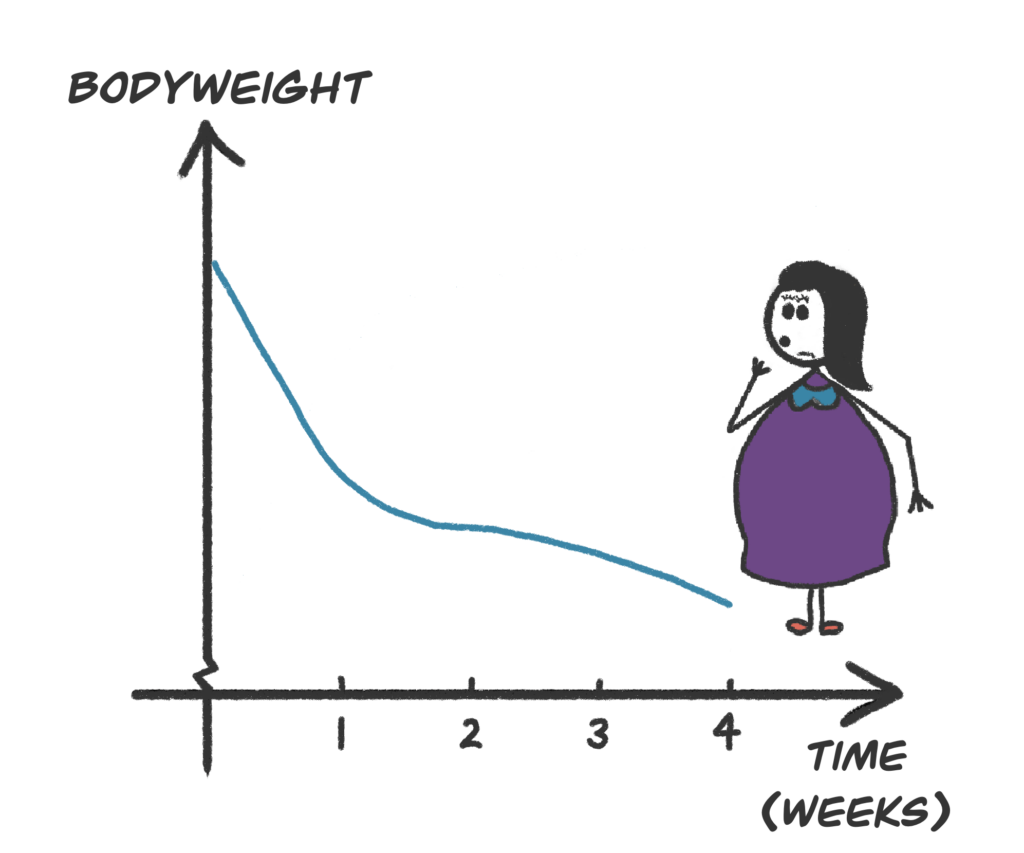
The body weight changes at the start of a cut can be confusing, even when plotting weekly averages.
The large initial dip you see is due to the loss in gut content, water, and glycogen stores. — Less food eaten means a lower average gut content. Your carb intake will be lower, which means your glycogen stores (and thus water levels) will be lower.
Your first week of data will be fairly useless then. Your second week of data onward starts to become useful, but it takes a few weeks to assess the trend.
Additionally, if you’re new to calorie and macro counting, you can expect to make some mistakes in the first week or two, which will add more noise to the data.
Women need to wait four weeks so they are comparing the same time of their monthly cycle.
For this reason, I suggest you always ignore your first week or two of data before attempting to assess progress.
Finding the Appropriate Initial Calorie Adjustment When Cutting
Let’s say you are aiming to lose 1 lb per week, and your weight data looks as follows:

The rate of weight change evens out after the first week, so discard that first data point.
Looking from the end of week one to the end of week four, it is clear that you’re averaging 1 lb per week of weight loss. As this is in line with your target, no adjustment is needed. This also means that of the five pounds you dropped in the first week, four are likely explained by gut content, water, and glycogen changes. You can expect to gain these back when you bulk or take a diet break.
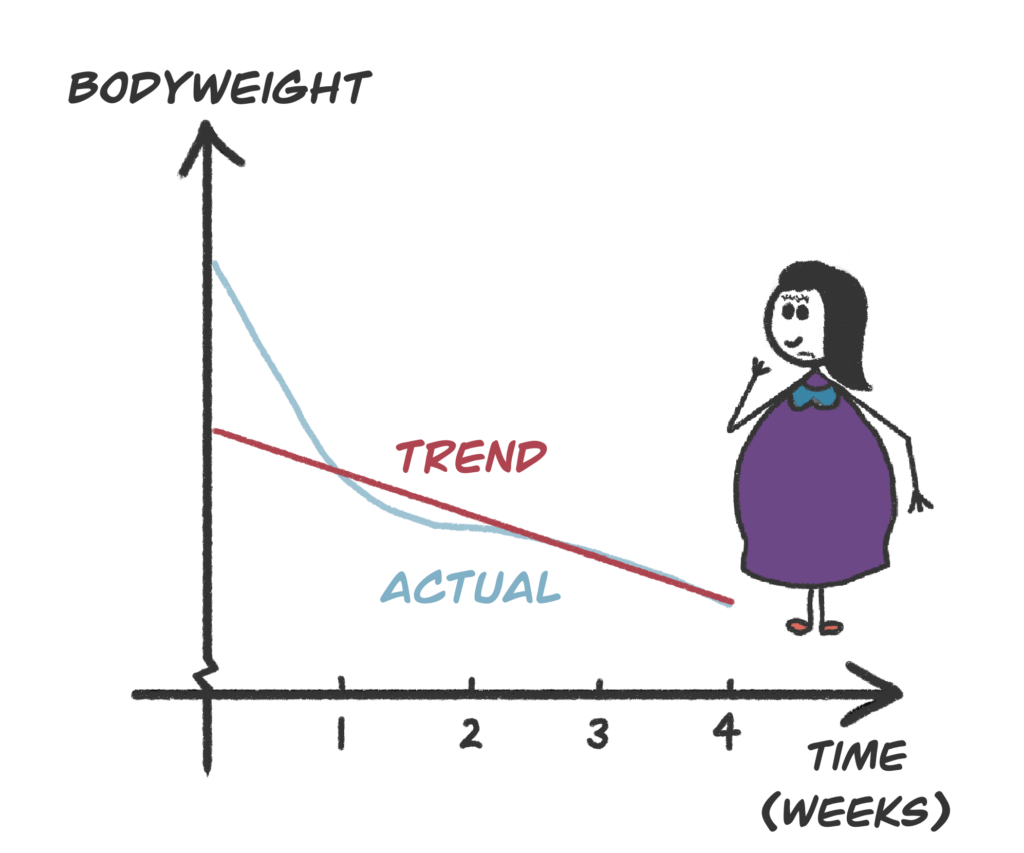
The trend only becomes clear if you give it time.
But let’s say your rate of weight change was above or below your target. How would you adjust?
Well, we know that we need a daily deficit of approximately 500 calories to lose 1 lb of fat, so here’s the formula we can use:
Daily calorie adjustment = (Actual rate of weight loss – Target rate of weight loss) x 500
👉 If your rate of weight loss is 0.5 lbs slower than your target, you need to subtract 250 kcal daily.
👉 If your rate of weight loss is 0.4 lbs faster than your target, you need to add 200 kcal daily.
(Water fluctuations happen with hormonal changes across the menstrual cycle. For this reason, I recommend that women wait one more week so that they can compare their weight data at the same time in their monthly cycle, without the first week of losses screwing up the assessment.)
So now the next question is, “How should I change the macros to achieve these calorie changes?”
I’m glad you asked…
Choosing What Macros to Adjust When Cutting
We want to choose the least compromising way to reduce calories from our diet. Recall from my nutrition setup guidelines the broad function of the three macronutrients:
👉 Protein is important for satiety and muscle mass retention.
👉 Carb intake is important for maintaining training quality.
👉 Fat intake is important for hormonal function and for keeping your diet from being boring as hell.
Arguably the most important of the three is protein. Unless you’ve set your protein intake higher than I have suggested, I’d recommend that you keep protein the same and reduce calories from a mix of carb and fat intake.
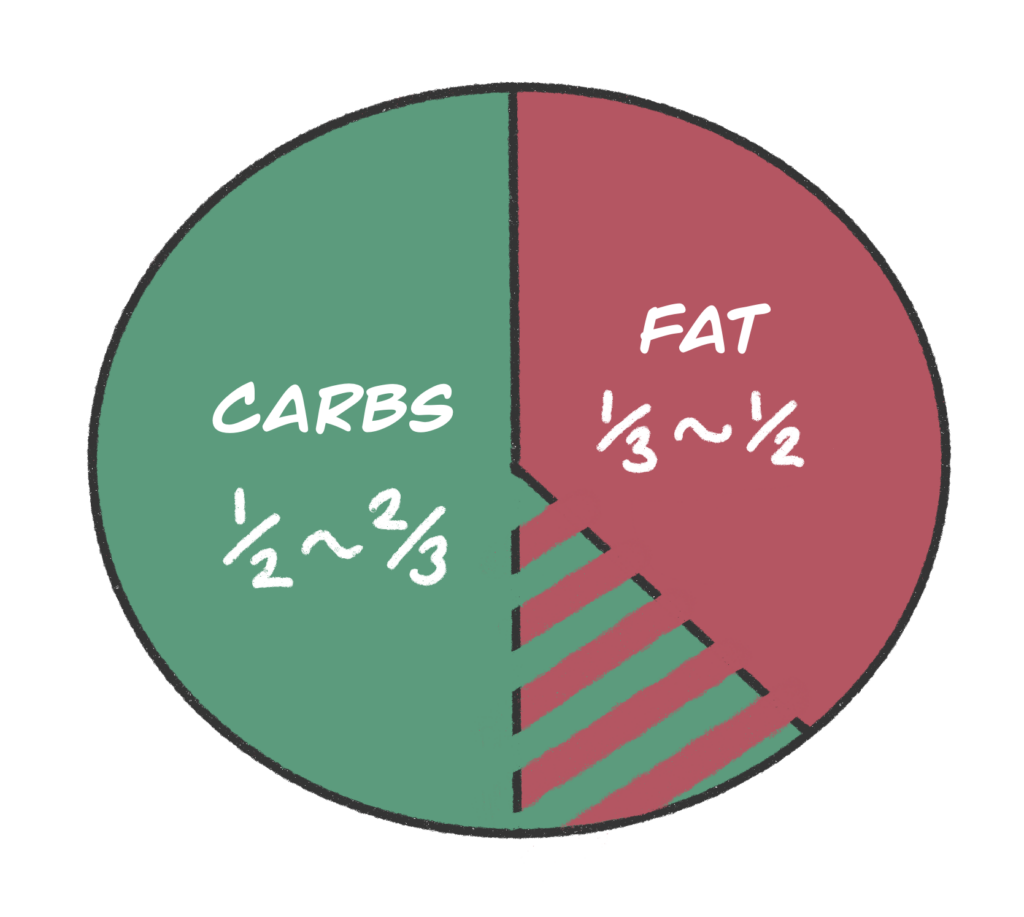
Make your calorie reductions in this ratio when cutting.
If you’re following my macro guidelines, you’ll almost always have a little more room to reduce carbs than fats. Therefore, I’d recommend your calorie reductions come from somewhere between a 1:1 and 2:1 ratio of carb and fat calories, respectively.
Bearing in mind that 1 g of carbs is 4 kcal, and 1 g of fats is 9 kcal, here’s a quick reference table of how to make reductions of different calorie amounts.
MACRO ADJUSTMENT EXAMPLES BY CALORIE AMOUNT WHEN CUTTING
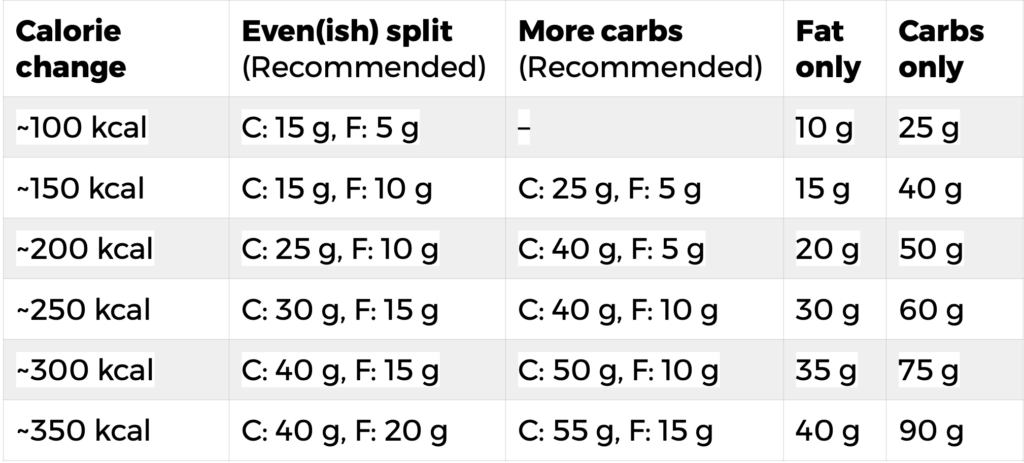
Note: I always round daily macro targets to the nearest 5 g.
👉 So, if you need to reduce your calorie intake by ~250 kcal, I recommend you achieve this by either reducing 30 g of carbs and 15 g of fats or 40 g of carbs and 10 g of fats daily.
👉 If you need to increase your calorie intake by ~200 kcal, I recommend you either add 25 g of carbs and 10 g of fats, or 40 g of carbs and 5 g of fats daily.
If you cycle your macros when you come to reduce (or increase) your calories, feel free to adjust your macros on the training and rest days independently.
👉 So, if you need to reduce your calorie intake by ~250 kcal, it would be fine to achieve this by reducing 30 g of carbs and 15 g of fats on the rest day, and 40 g of carbs and 10 g of fats on the training day instead.
WHAT TO DO IF YOU CYCLE MACROS
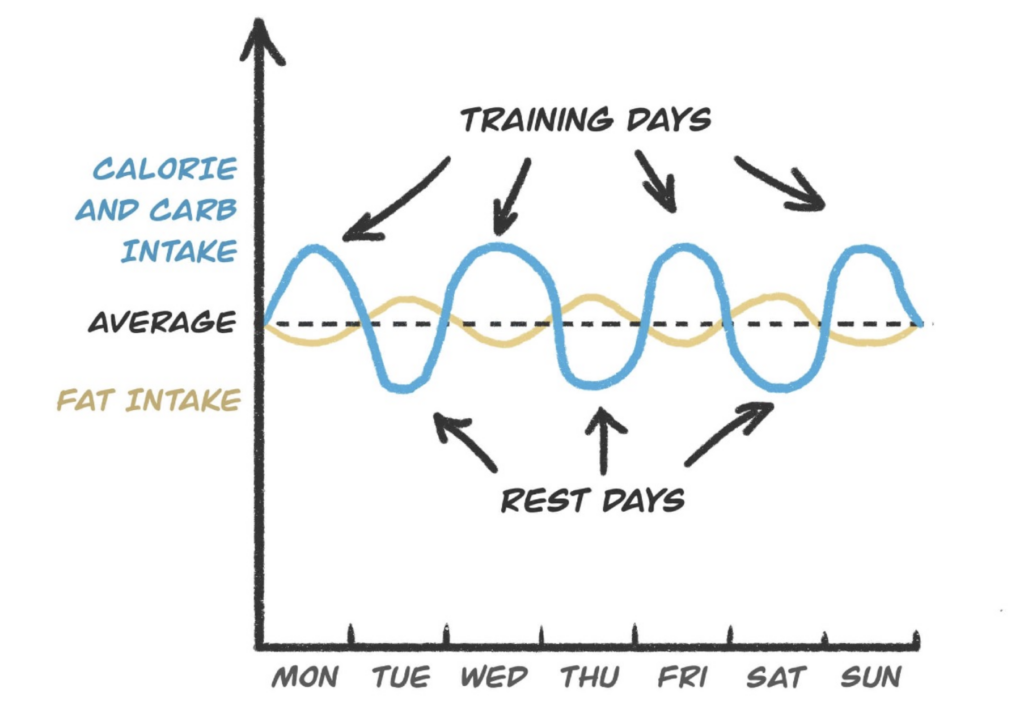
You can set up your diet to have more calories on some days than others. This is sometimes called calorie cycling. As you cannot calorie cycle without the macros changing, it is more commonly referred to as macro cycling.
You’ll have likely read about macro cycling in The Nutrition Setup Guide. If you haven’t read those or don’t recall what was there, the key takeaway is that macro cycling is unlikely to give you a better result than a diet where calories and macros are the same each day. So,
- If you feel that macro cycling unnecessarily complicates your diet and you find it harder to adhere to, I recommend you avoid it.
- If macro cycling breaks up the monotony of dieting and therefore you find it easier to adhere to, I recommend you consider it.
The simplest and most common way to cycle macros is by adjusting carb intake. — If you have a four-day training week, instead of consuming 200 g each day, for example, you may consume 275 g on your training days and 100 g on your rest days.
You may choose to fluctuate your fat intake also, and this is what I commonly do with clients. But this is because the clients I work with have experience counting their calories and macros, and most appreciate some variety in their diets.
So when you see differing macros for the training and rest day intakes in the client examples later in the book, please don’t be under the impression that it leads to better results.
ADJUSTING INITIAL CALORIE CALCULATIONS WHEN BULKING
Roughly the opposite of what I wrote in the previous section on cutting is true when bulking. But there are some notable differences.

The body weight changes at the start of a bulk can be confusing also.
Your body weight data (represented by the blue line) will look roughly the inverse of what it did when beginning to cut. The trend may take longer to become clear though because your target rate of weight gain is likely to be less than your target rate of weight loss.
(Recall that the recommended rates of weight loss are typically in the 0.5-1% per week; recommended rates of weight gain are in the 0.5-2% of body weight per month.)
Again, the first week of data will be fairly useless, and the second may well be also if you’ve been restricting carb intake and as your glycogen stores will take a while to fill. This means that it would be prudent to wait six or seven weeks before making any adjustments to your bulk calculations.
Yup, you read that correctly.
Sometimes I make changes earlier than this with clients, but I have a ton of experience spotting trends in data. You don’t. Premature adjustments increase noise and make your data harder to interpret. When in doubt, be patient.
Finding The Appropriate Initial Calorie Adjustment When Bulking
Let’s say you are aiming to gain 0.75 lbs per week (~1.5% of your body weight per month), and your weight data looks as follows:
| Starting weight | 160 lbs |
| End of week 1 average | 165 lbs |
| End of week 2 average | 168.9 lbs |
| End of week 3 average | 169.5 lbs |
| End of week 4 average | 170.1 lbs |
| End of week 5 average | 170.4 lbs |
| End of week 6 average | 171.0 lbs |
| End of week 7 average | 171.4 lbs |
It’s clear that the rate of weight change evens out at the end of week two onward, so discard the first two weeks where you have the glycogen, water, and gut content gains muddying the data.
From the end of week two to the end of week seven, you’ve gained 2.5 lbs, which means you are averaging 0.5 lbs per week of weight gain. This is a rate of 2 lbs per month, which is 1 pound slower than your target. You need to make an adjustment. But how?
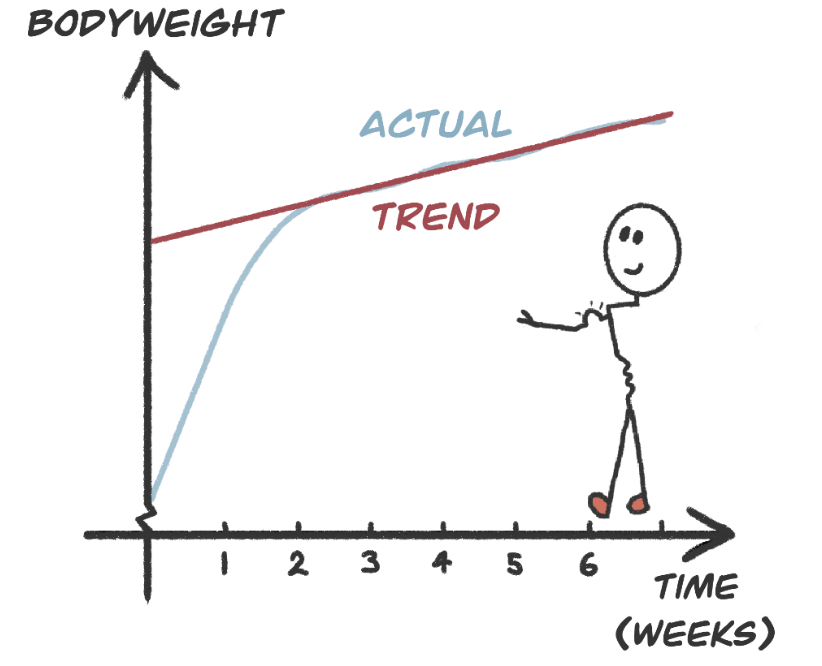
The trend can take even longer to become clear when bulking.
It takes roughly ~2500 kcal to build 1 lb of muscle and ~3500 kcal to burn or store 1 lb of fat.
Though some do better than others, on average, I see clients gain fat and muscle in a 1:1 ratio during a bulk phase. So, if we hold this as the assumption, and also assume a 30-day month, we will need a 100 kcal daily caloric surplus to gain 1 lb of weight per month (~220 kcal for 1 kg).
However, recall from the Why We Need To Make Adjustments chapter, that there will be an increase in energy expenditure from NEAT whenever we increase our calorie intake. We can’t predict what this will be, but we know it will happen to a degree, and I suggest we add 50% on the front end to account for it rather than delay things unnecessarily.
This gives us the following heuristic:
To gain 1 lb of weight per month, add 150 kcal each day (330 kcal for 1 kg).
👉 So, as weight gain was 1 lb short, add in 150 kcal each day.
Choosing What Macros to Adjust When Bulking
When cutting, our concerns were reducing the macros in the least compromising way possible so that training quality and muscle mass retention aren’t affected.
When bulking, our concern shifts toward optimizing for muscle growth without an undue amount of fat gain.
Muscle growth doesn’t happen so quickly to justify increasing protein intake beyond the point where it is initially set. Therefore, as with the cut, the calorie adjustment will come from manipulating the carb and fat amounts.
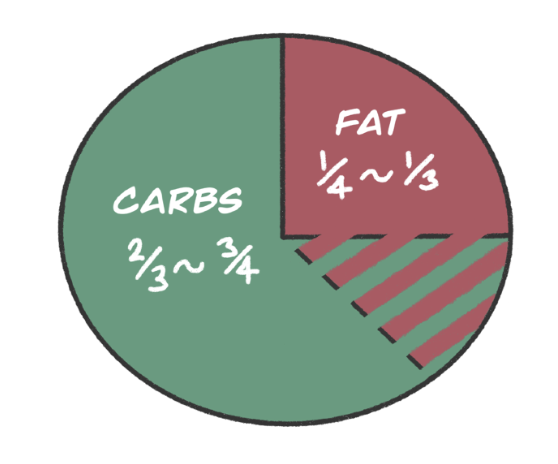
Make your calorie additions in this ratio when bulking.
As you’ll have read in either The Nutrition Setup Guide or The Muscle and Strength Pyramid: Nutrition, I recommend keeping your fat intake between 20-30% of your total daily calorie intake when bulking. To maintain this, I suggest you make calorie increases by bumping up your carb and fat intake somewhere between a 3:1 and 2:1 ratio, respectively.
Here’s a modified reference table of how to make increases of different calorie amounts:
MACRO ADJUSTMENT EXAMPLES BY CALORIE AMOUNT WHEN BULKING
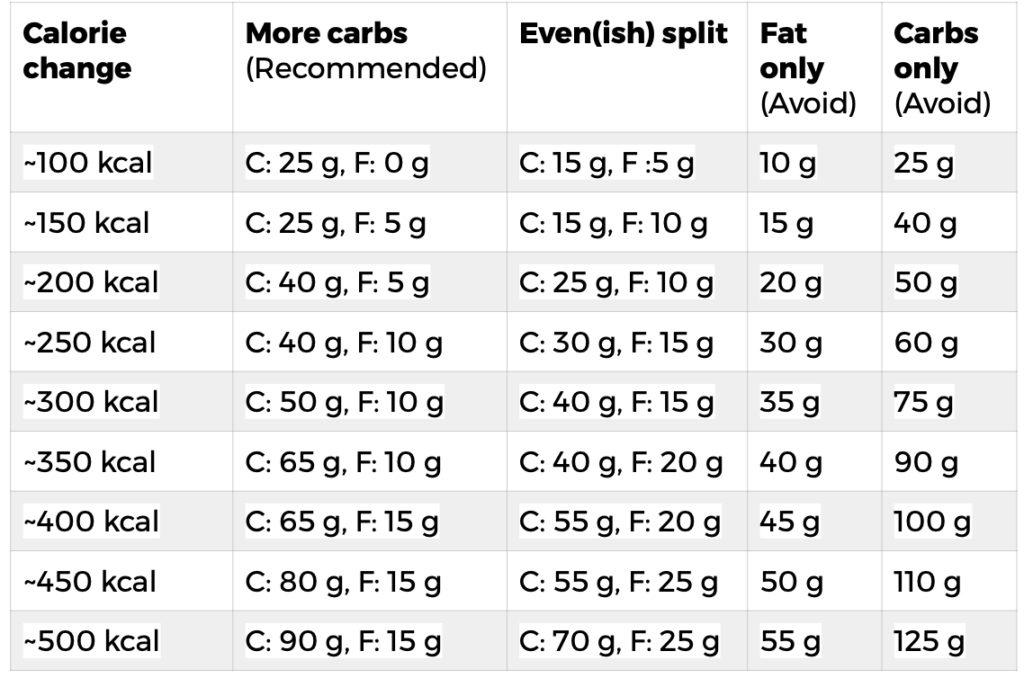
If you need to increase your calorie intake by ~150 kcal, I recommend you achieve this by adding 25 g of carbs and 5 g of fats to each day.
If you cycle your calorie and macro intake, adjust your training and rest days by the same calorie amount but feel free to choose different macro adjustments to achieve it.
Thank you for reading. This was a sample chapter from my book, The Diet Adjustments Manual 📙.
Questions are welcomed in the comments and I answer daily.

Privacy policy.